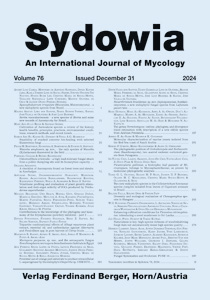
Volatilome profiling and evaluation of plant growth stimulation and Anti-ergot activity of VOCs produced by Trichoderma asperelloides Appusami Sudha, Dhakshinamoorthy Durgadevi, Manickam. Rajesh, Alaguthevar Ramalakshmi, Shanmugam Kavitha, Kahkashan Perveen, Najla A. Alshaikh & Riyaz Z. Sayyed Sydowia 76: 95-111 Published online on November 10th, 2023 Ergot infection of sorghum is the most devastating; in 2019, it caused 10–80 % crop loss. The pathogen produces sclerotia that contain the lethal “ergo-toxin”. A simple, economical, and sustainable method is needed to control this disease. This study aimed to evaluate plant growth and biocontrol potential of Trichoderma species isolated from rhizosphere soil. It revealed that volatile organic compounds (VOCs) of Trichoderma spp. exhibit more mycoparasitism against Claviceps sorghi, promote sorghum growth, and tripartite interaction, compared to commercial volatiles. Thirteen Trichoderma isolates were identified based on specific gene and phylogenetic analysis. The intron 3 regions of the ß-tubulin gene and the intron 4 region of EF-1a confirmed one isolate as Claviceps sorghi. All isolates produced chitinase and glucanase and inhibited (78 %) C. sorghi growth. Isolate ASTA13 produced 53 volatile compounds identified based on gas chromatography–mass spectrometry (GC-MS) characteristics. Crude extract of ASTA13 inhibited C. sorghi mycelia growth at 67.62 and 79.16 % at 50 and 75 µl concentrations. Commercial volatiles (1-Nonanol, 2-Methyl-1-butanol) reduced C. sorghi growth by 74.40 and 84.77 % in vitro. Mycelia react oddly to volatile chemicals and phenyl ethyl acetate (PEA). Fungus promoted plant height (15.85 %), root length (35.50 %), and biomass (36.61 %). The T. asperelloides (ASTA13) strain showed good potential as a biological formulation for agriculture. Keywords: Commercial volatiles; C. sorghi; GC-MS; growth promotion; Sclerotia; Trichoderma, VOCs. |
 |